PITTSBURGH STEELERS FILM ANALYSIS - HOW TO USE ANTONIO BROWN
By Tyler Arthur
What did Pittsburgh do, and what should Oakland Try to do?
The exciting acquisition of Antonio Brown, an elite wide receiver in his prime, by the Oakland Raiders was undoubtedly a move that offers a huge addition to an offense that struggled last year. However, people haven’t reacted the way that you might expect.
When you combine the defensive overhaul in the shape of Lamarcus Joyner and a group of rookies to help bolster the catastrophic defense of last season, this offseason has without question been a positive one for Oakland.
Despite all this, what does everybody say about the addition of the superstar wideout?
‘Derek Carr isn’t good enough to sustain AB.’
‘Without Big Ben he won’t be the same.’
This article isn’t about trying to prove Derek Carr is an elite quarterback or that he will be better than Big Ben. I don’t think he is an upgrade for Brown, or anything like that. What I can do, however, is work out what the Raiders can do to make him most comfortable.
To do this, I decided to take a look at the Pittsburgh film, in order to try and work out what that magic formula was.
What does a team have to do to best make use of the supreme talent that is Antonio Brown?
The Steelers Plan
The Pittsburgh Steelers are a team that for so long were symbolised by hard-nosed, defensive minded old school football. With iconic players like Troy Polamalu and ‘Mean’ Joe Green in their past, they had always been a franchise priding itself on grit and physicality. Not to say that they aren’t a good defensive team, or that they aren’t physical, anymore – but the Steelers transformed themselves into a team that is more feared for their offense than almost any other opponent in the National Football League. Le’Veon Bell didn’t play this past season and they still dominated defenses. They put up the sixth most points on offense finishing only behind some true offensive powerhouses: Chiefs, Rams, Saints, Patriots and Colts.
So, the offense was good, we can see that. James Conner provided an impressive replacement for the absent Bell, who many assumed would be – well, irreplaceable. The team was still very favourable to the pass, looking to expose mistakes for big chunk plays, while also boasting a dynamic and varied quick-passing game to move the chains. Most importantly to us in this article, those plays that they geared up to make use of their superstar wide receiver.
Formations
First things first, as with calling the play – the formation comes before anything else. The formation is very important to the call because it not only sets you up to do your play on offense, it also directly influences the defensive players. There are three key elements of a formation that the Steelers used to help Antonio Brown in various ways.
Firstly, they often isolated him on his own. When you run a mirrored, spread offense, the first weakness is that a mirrored defensive scheme will be able to match up against you and theoretically stop you. When you have an imbalanced formation, for example a trips formation to one side (a Steelers favourite, usually two receivers and a TE close), it often forces the other team to rotate their resources that way too. This creates mismatches, forcing cornerbacks to try and cover Brown in a one-on-one matchup. If not one-on-one, at the very least, it reduces the amount of zone defenders that are around him.
Here is a great example of the Pittsburgh formation drawing a favourable matchup for Brown, against the Carolina Panthers.
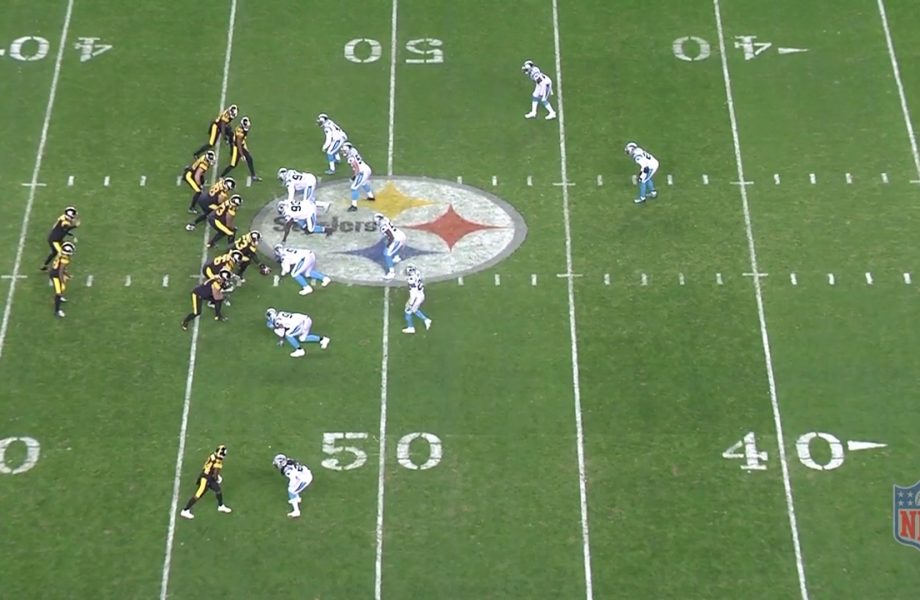
The Steelers have opted to set up in the formation ‘Gun Bunch Weak’. This formation has two wide receivers and a tight end bunched up close to the offensive left side of the line. The good thing about this formation is that it still threatens the box enough for a potential run play, most commonly a zone running play to the left, as per the positioning of the running back to the opposite side.
This play however, definitely isn’t a run play. If it was… It isn’t anymore.
As I said before, through the use of their formation, they have created an isolation, a mismatch. Antonio Brown is stood on his own, with a second-round rookie cornerback in press coverage, on an island. There is absolutely no help whatsoever if AB beats him, especially when the nearest safety walks down into the box late.
We don’t need to break this one down – he beats him.
Number 84 does what number 84 does, he wins at the line of scrimmage, and then it’s too late for the defense. He ran a straight up nine route, nothing special, no trickery. A simple ‘go’. He beat cornerback Donte Jackson down the sideline, and scored a 53-yard Touchdown.
All it took was a change in the formation to put a young corner on an island with one of the greatest receivers to ever play the game. Oakland will need to find these mismatches to best utilise Brown’s ability as a deep threat.
The second way to create favourable matchups with Brown is through putting him in the stack or bunch formations, earning him a free release off the line. This then prevents those covering him from getting aggressive. Another benefit to this is that when the two or three receiving threats explode out into their routes, the defense has to track them all, and Brown can use the smoke and mirrors of the likes of JuJu Smith-Schuster and Vance McDonald to help him expose the weaknesses in the coverage. If they don’t go with zone coverage, good luck to whoever is trying to run with him, it won’t go well, we’ll talk about man coverage later.
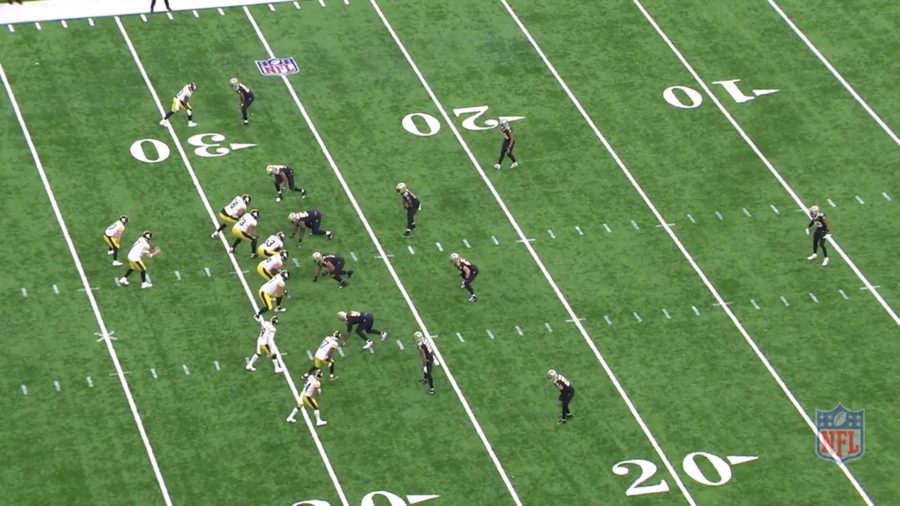
Here we can see the Steelers using a similar look to what we previously saw. However, now, against the New Orleans Saints, who have been following him around the field with their number one cornerback Marshon Lattimore, Brown is actually in the bunch. You can see Lattimore at the bottom of this picture, he is still following Brown around the formation, but can no longer press him. He can’t press him when he is at the back of the stack for obvious reasons, but teams also have to play to certain rules when they face a tight alignment like a bunch formation or a tight stack of receivers.
If you play man against bunch you are putting your defenders at the mercy of unavoidable traffic, and if you play zone you need to cover the zones that are wider than the bunch, meaning that the usually aggressive press-corner is now stood at a more generous seven yards of depth.
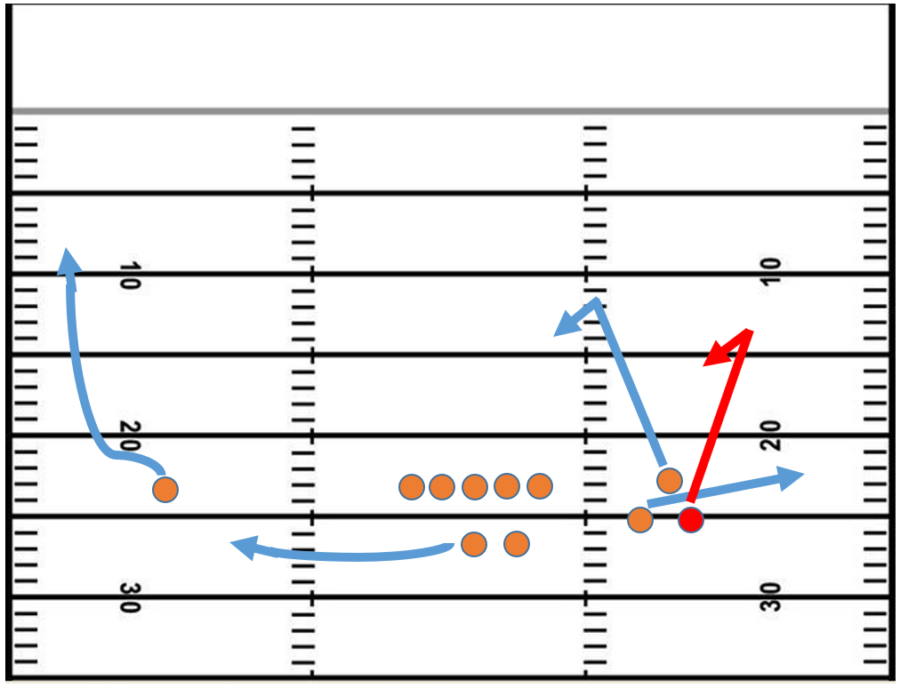
Now that they have created this cushion of space, and also strongly suggested to the Saints that they’d be best off in a zone coverage, they can attack it.
They do so by using a spacing concept to stretch the zones in the area of the field in front of the bunch. Brown has a curl route, which he runs by attacking the outside shoulder of Lattimore. In doing so, he identifies that the New Orleans young cornerback is backpedalling and has responsibility for him going deep. This allows the veteran to break down quickly, turning back towards Ben Roethlisberger to receive the ball and gain a first down.
The second curl route held the inside defensive help, and the flat route from JuJu holds the only other potential threat to Brown getting open in the flat zone. Ultimately, it gives just enough of a pocket for the reception and a handful of yards. By using the bunch to give their star receiver a free release, against zone coverage, you are giving him the opportunity to use his ability to read the space and the coverage, to settle in a spot where Ben can throw the ball.
Finally, the third key way of using formation to benefit Brown is my personal favourite. The empty sets. After watching film, I think it was Pittsburgh’s favourite too.
Note that I am not referring to this as a personnel change, but a formation. The Steelers didn’t bring in a fourth wide receiver when they went five-wide, they used a running back – usually James Conner – and that was the beauty of it.
I just told you how giving Brown zone coverage is great, and that is true, he is adept at reading and reacting to the space that is available. His rapport with Roethlisberger makes it easy for him to adjust his route on the fly. This ensures that he best exploits the weaknesses of the look he’s being given. However, the reason that the empty set is so effective is the opposite, it often gives Brown a go against man coverage. Obviously, teams don’t have to react the same way every time that James Conner splits out as a fifth receiver. However, they will more often than not default to man coverage, and put a linebacker out to cover him in man (or if they opt for nickel personnel a safety or nickel corner). But here is where it becomes dangerous. The Steelers like to put Conner next to Brown.
When an elite wide receiver is given man coverage, it’s tough to cover him, that much is obvious. Now there’s an elusive running back split out next to him, with a linebacker covering him. Suddenly you have a safety over the top who’s got a nightmare on his hands. Let me show you what I mean.
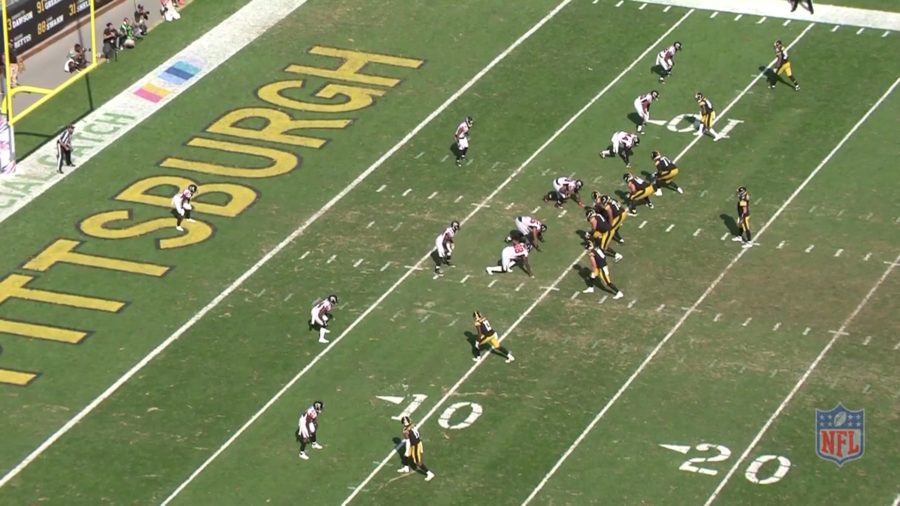
In the redzone against the Atlanta Falcons, the Steelers come out and line up in an empty formation with, as I explained, three receiving threats to the left and then Antonio Brown and James Conner on the short side of the field. In this particular formation, they have put the halfback on the outside, in a very wide split, and Brown is in the slot, on the numbers.
The look that they got in return is exactly what they would expect. The Falcons are clearly in man alignments, including a definitely-not-a-cornerback lined up over Conner. Linebacker Duke Riley has that job, and Isaiah Oliver, a defensive back, up close, but not fully committed to press on Brown. The wide side of the field is equally obvious and is mirroring the man coverage, however with a more generous cushion. There is one true high safety, and the second is sat at an intentionally vague depth. That is to try and create the only real question that you may ask when reading this coverage – is it a two-high man, or a Cover 1 Robber? That is dictated by whether that safety drops back or robs a route to help one of the underneath man defenders.
The funny thing is, it doesn’t matter. It could be Cover 2 man, or Cover 1 Robber, either way, the Steelers offense has the play dialled up. It’s 3rd and 2, they have to make it happen, and they’re about to.
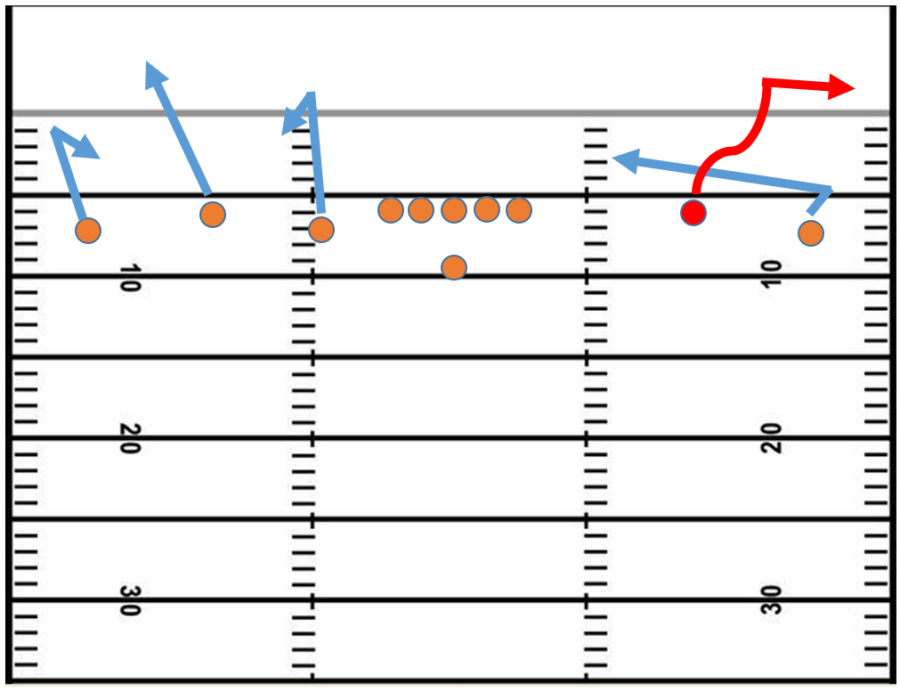
The Steelers dialled up a simple but effective quick passing route combination, with Conner running a bullet slant in underneath Antonio Brown’s out route into the end zone. The reason that this play call was so perfect is because whether the second safety has the responsibility of playing half of the field in a two-high shell, or if he was a robber (if he was, he would undoubtedly be doubling Brown) he can’t get there to stop an outward breaking route. Brown stems hard outside with his release to stack Oliver inside. This gives him the leverage he needed. Now with two defenders trying to stop him, both of them are behind him when he turns towards the sideline.
This play is very much a half-field read. The one-step slant benefits from the rub as the linebacker on the outside has to navigate traffic when Brown stems toward him. This means that if the defense are somehow able to stop the primary threat, Conner should be able to beat his man anyway and turn up into the vacated space behind the two defenders who have managed to get across to the outside.
What happened in reality is what the Steelers could expect eight times out of 10. Brown scored a Touchdown after a perfectly placed, and pretty much uncontested anticipation throw, leading him toward the pylon.
Scheme / Play Design
No matter how good your formation is, the play design is crucial to success. There were some plays that were really effective for Brown in Pittsburgh. For example, that previous design in the redzone was not the only time where the Steelers employed a rub concept to get him open. The rub is one of the most popular quick passing concepts in the NFL. Any fast receiver will benefit from getting just an extra step on the defender who’s in man coverage, and that is exactly what the rub achieves.
Here is a really interesting play that happened against the Falcons. Earlier in the same game as the previous play we looked at, they came out in a slight variation of that empty formation. Antonio Brown and James Conner again find themselves paired together on the two-receiver side, opposite trips. They are once again to the short side of the field, however this time we see Brown on the outside and Conner is in the slot.
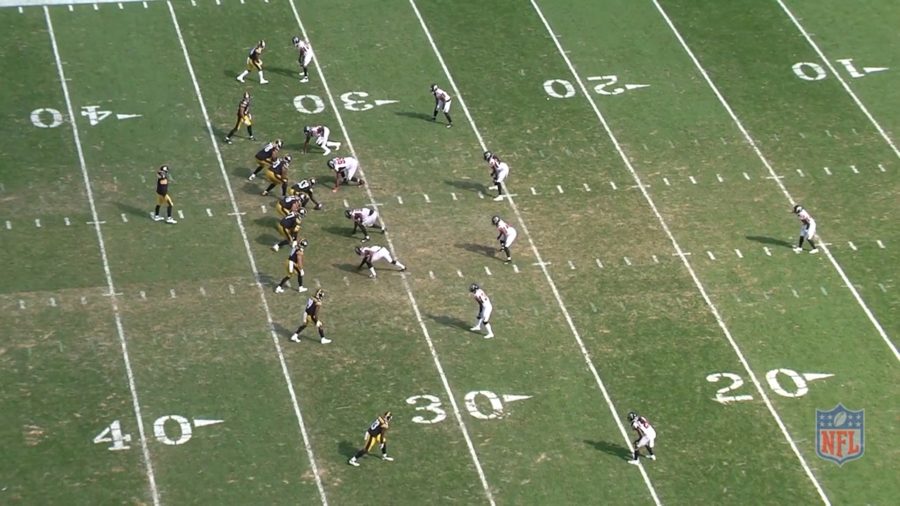
This should look fairly familiar, in terms of the formation, however the Atlanta defense tries to mix up the look they give in response. The top side looks how you would expect with the common man coverage against the empty set. However, with a safety on Conner this time instead of a linebacker, but still – they’re showing man.
Now take a look down at the bottom of the field. The exact opposite look is visible here. Atlanta cornerback Desmond Trufant is stood seven yards off with an outside shad. His hips and eyes firmly aimed towards the Quarterback – screaming zone coverage, more specifically a Cover 3 or Cover 4.
So, there are two contrasting looks, one side of the field looks like it’s in man, and the other side looks like it is in zone. This is something that you will sometimes see if the defensive personnel features a superstar lockdown corner like Xavier Rhodes, who will be in man coverage no matter what the other players are doing, but in this case it isn’t that simple.
The play that the Steelers have against this provides another rub concept to the topside, with Brown this time on the in-breaking route, and James Conner running a speed out. James Washington is running a fade to clear out Trufant down the sideline, with two more quick outs underneath on the wide side of the field.
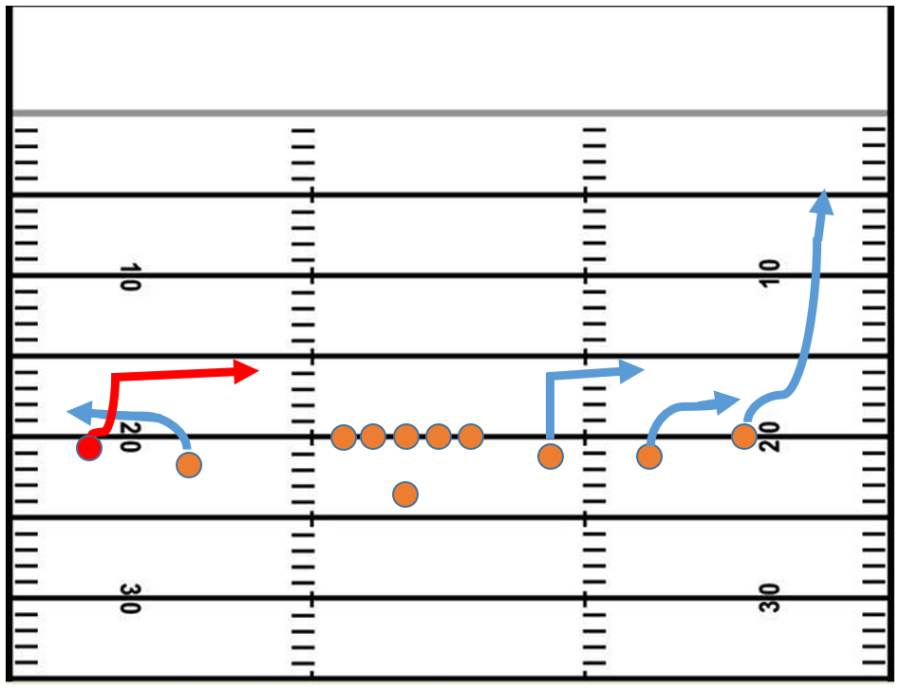
The offensive element of the play calling battle that’s happening is not what makes this play interesting, it’s that unpredictable defensive look. Half of the field looks like it is in man and half of the field looks like it is in zone.
And that’s because that is exactly what it is.
The Falcons have dialled up a hybrid coverage for this play – with Antonio Brown and James Conner covered by two man-coverage defenders, and everyone else running a zone coverage.
The coverage that they are in is somewhere caught between a Cover 3 and a Cover 4 due to the trust from the single-high safety that he doesn’t need to cover the left side of the field. Either way, the three routes on the wide side of the field are irrelevant against this defensive call.
Ben has to make a quick read to the side of the field to confirm that it is man, and then as soon as he’s determined this, he’ll know that either Brown or Conner should get open on the rub. The difficult part against the hybrid look however, is that there will be zone defenders in the middle of the field. That will cause a problem for Brown once he breaks inwards – right?
It would be right, but Antonio Brown is that good. He stems inside and breaks on his in route, gaining great separation when his man has to avoid his own teammate, and then, all while running his route, he identifies that there are zone defenders in the middle of the field, and slows down to settle before he gets there. Ben identifies this at the same time, and delivers the ball to Brown on an improvised spot. This allows him to plant his feet and turn back outside for some yards after the catch.
This is a mixture of two things, and I chose this example because of that. Not only does it demonstrate the successful use of a rub concept, but it also showcases how quickly Brown can identify what the defense is doing, and adjust to it. The absolute number one priority for Derek Carr this pre-season is to get on the same page with Brown, so that he can make this mid play audibles, like Big Ben did.
This awareness and ability to diagnose the coverage also makes AB’s curl routes dominant, but is most impressive when he is supposed to be running something else entirely. He might be running a post against Cover 3, but he decides instead to curl it off and sit in the seam to avoid running into coverage. Once the Quarterback has read the coverage, he should be able to work out how Brown should change his route and throw to that spot with confidence, something that will massively elevate the Raiders offense, especially on crucial third downs and in other high intensity situations, where Brown has to get open even if it means going off script.
Another very common thing that you will see if you watch Steelers games is the deep out route to AB. Out routes aren’t some schematic revelation from the Pittsburgh lab, far from it, but they have their guy run it different to how I’ve ever seen the route used before.
Every coach you’ll ever have would tell you an outside wide receiver’s alignment will dictate what routes they can run. Antonio Brown breaks every rule that this statement represents. He can line up outside the numbers and run an out route to the sideline. This is why people (mainly himself) call him Tony Toe Tap.
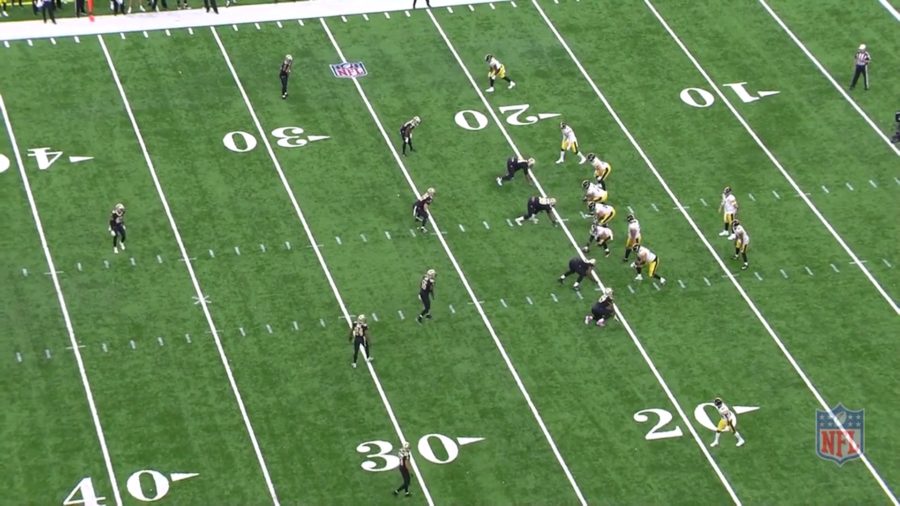
Here is a perfect example. It is 4th and 15. The Steelers are losing by three points to New Orleans, and they need to convert this crucial down to stay alive. They line up in the shotgun with a two by one look, and a tight end to the right side. Antonio Brown is split out on his own to the Roethlisberger’s left, with a slightly plus alignment (outside the numbers). Marshon Lattimore, who has done a respectable job of trying to tame him to this point, is still stood over him, but with a very comfortable cushion between them, due to the down and distance. He’s saying ‘you can’t beat me deep’. But the Steelers #84 doesn’t need to – he’ll beat you as deep as the down requires.
Fourth down, 15 yards to go; what does he run? A 15-20-yard out route, of course!
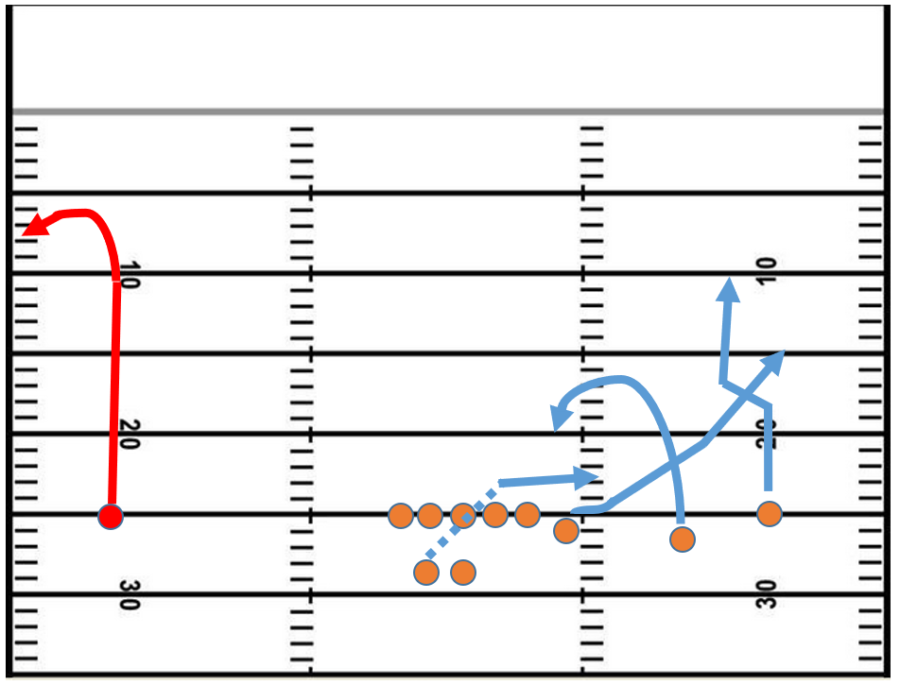
Don’t be alarmed by what appears to be a complicated play here. Literally only one route on this image matters. Antonio Brown is isolated on his own so that all of the defenders who may be in zone coverage are occupied as far away as possible, giving the master of out routes a one-on-one matchup with Lattimore, defending him deep.
AB reaches the first down marker, and then curves his route off, attacking the boundary and coming back to the ball for a 19-yard gain.
There are two key elements to this toss and catch: 1. Brown has to be on his own with the only defender over the top of him at the time he breaks; 2. Roethlisberger has to throw the ball at the exact right moment so that it meets his target at the sideline, on time.
This is where Derek Carr really has to work hard. One thing that many people say about DC4 is that he has become accustomed to throwing the ball underneath too often. He doesn’t use his (in my opinion, underrated) deep ball ability enough. He likes to get the ball out quick. I don’t doubt that the Raiders signal-caller has the ability to throw a ball to the sideline 19-yards down the field – but can he deliver that pass to a man at the exact moment he breaks, so that it can meet him at the boundary before a defender can react?
One final schematic usage of Brown that I found really interesting is the exotic screen plays they gave him, utilising unconventional blocking schemes on screens to get the ball in his hands straight away. Some more recognisable screen designs were used, but not worth breaking down. Then I saw this play against the New Orleans Saints, a team known themselves for their creativity.
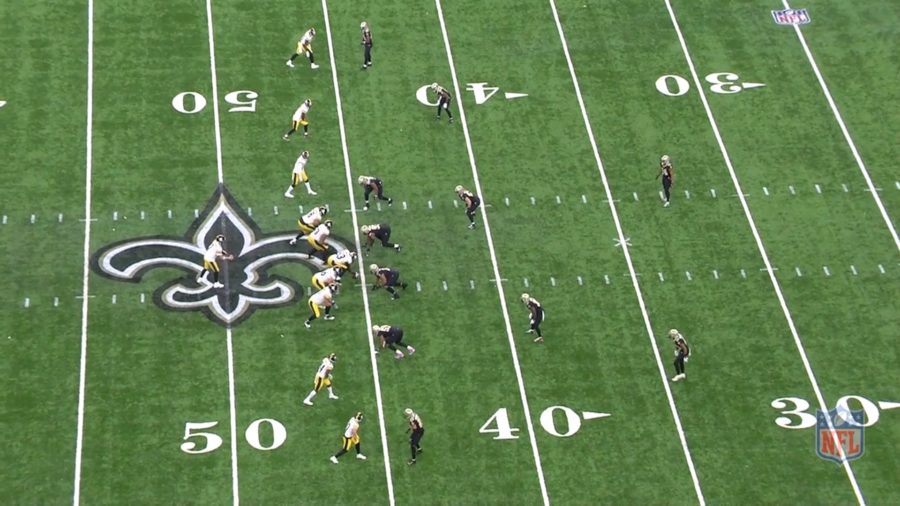
The Steelers are using their beloved empty set again, and as usual, Antonio Brown is split out to the short side of the field, although this time he has a fellow wide receiver outside him instead of James Conner. Instead, he is next to ex-Raider Ryan Switzer.
The benefit of using this formation to run this screen is that, if you have been paying attention hopefully you remember this, they will likely get a man coverage look against the empty set, and Lattimore usually doesn’t move into the slot. This translates to off-man coverage on Brown being the most likely look – and not from their best defensive back. This play gets the ball in his hands early and gets a couple of blockers in front of him, in one of the more creative ways I’ve seen.
Before we can take a look at the play itself, first I need to give you guys a second angle of the pre-snap. Don’t get too excited, but yes, we’re taking a look at some offensive line play.
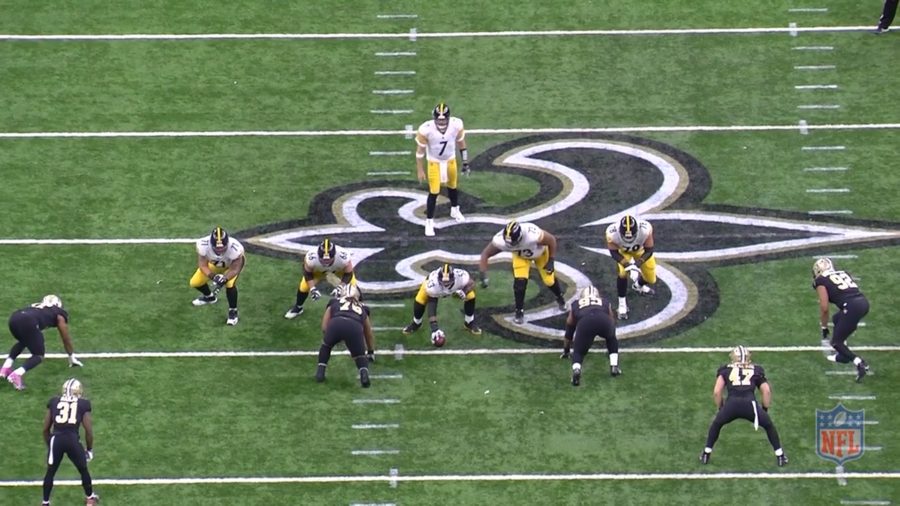
The Saints defensive line has three down-linemen and one two-point rusher on the defensive right side of the line. Number 92, Marcus Davenport, is stood in a nine technique, which is also mirrored by the widest down defensive lineman, with the other two inside. The playside tackle is in a 2i technique, meaning that he is on the inside shoulder of the right guard, and his opposite teammate is in a three tech. Behind the line there is some beautiful open space, due to the fact that the New Orleans are in their dime package – because they know that it is a pass play – leaving just one true linebacker, and a vaguely near-the-box safety.
This is literally perfect for the play call that we are about to see. And I mean perfect.
Now let’s take a look at the play art.
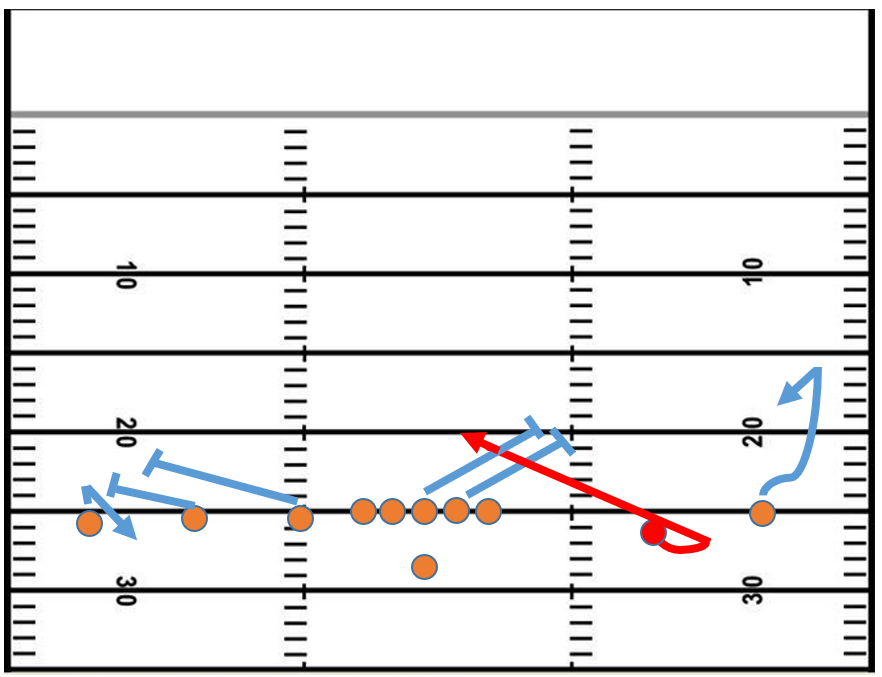
This screen is genius, and it is beautiful to watch.
As you can see in the play art, the Steelers are actually going to use their right guard and their centre to block for this underneath screen to Antonio Brown, who fakes a bubble screen, but plants his foot in the floor, and gets the ball straight away, allowing the two big boys to get upfield. As the two interior linemen double the 2i technique, they direct him into the into the path of the defensive back who is trying to play man coverage on Brown, and all of a sudden, he has space to move in and gets 17-yards (of which 19 were after the catch).
There is just so much that Brown can do. Through correctly using formations and play design to let him loose – particularly in the ways that I have highlighted here – the Oakland Raiders have the opportunity to unleash one of the best to ever do it, and I can’t wait to see it.
Some elite wide receivers have played in silver and black.
Tim Brown.
Randy Moss.
Jerry Rice.
Antonio Brown.

Tyler Arthur
NFL FILM AND PROSPECT ANALYST
A GRADUATED JOURNALISM STUDENT, TYLER ALSO WRITES FOR READ AMERICAN FOOTBALL AND GRIDIRON HUB. HE PLAYED WIDE RECEIVER AND QUARTERBACK FOR HIS UNIVERSITY TEAM AT DMU, AND IS NOW USING HIS KNOWLEDGE AND PASSION FOR LEARNING TO DIVE DEEPER INTO THE ANALYSIS OF X’S AND O’S IN THE NFL.
Photo Credit: USA Today
